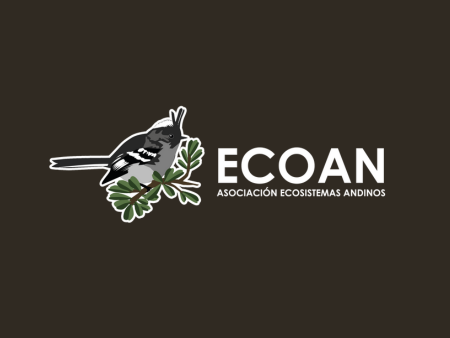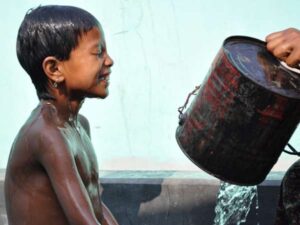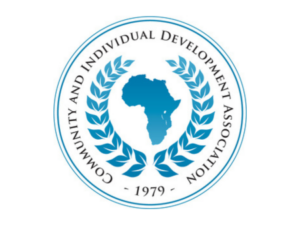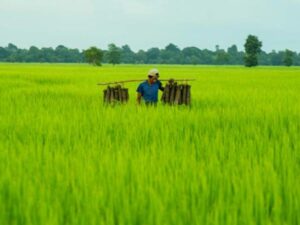Ecoan is dedicated to conserving the flora and fauna species in danger of extinction and threatened ecosystems.
Constantino Aucca of Ecoan spoke with Ambika-Samarthya Howard on July 31, 2025. Click here to read the full conversation with insights highlighted.
Ambika-Samarthya Howard: Can you start by introducing yourself and your organization?
Constantino Aucca: My name is Costantino Aucca, and I’ve spent most of my life doing conservation work for the Andean Mountains. In 2000, I founded the Asociación de Ecosistemas Andinos (ECOAN). We work to protect and restore threatened ecosystems in Peru’s Andean Mountains through initiatives like Acción Andina.
Ambika-Samarthya Howard: In terms of the people engaged in this work, are they people who have experience in these areas? Are they the best fit for this work?
Constantino Aucca: There are a lot of people involved, and usually they are good leaders, the best leaders, but the problem is they change their minds because they find the opportunity to receive a better salary. In that way, they lose their passion, they lose their love, they lose everything. It’s like they sell their minds for money. A lot depends on how much you are paying them.
For instance, when we sit around tables or in workshops and talk about resilience, the conversation becomes, What kind of resilience? How much does your resilience cost? Resilience means reacting to a problem in a positive way. If you have a big problem, you figure out a positive way to solve it, but not because somebody is paying you.
In the past, many cultures effectively reacted to their problems by using positive resilience. They said, We suffer, we have a terrible problem, and we do not want to experience this again. This is what I tell everybody. In the United States, I say, Hey, you have all the power, you have many things. You are good people. Why are you waiting and watching suffering instead of reacting in a positive way? Some people ask me what I’m talking about. I tell them, The world of money is changing what it means to have a good heart. For that reason, we are not achieving goals in the proper way that the planet requires.
Ambika-Samarthya Howard: You grew up in the Andes, right? What were you seeing there that compelled you to do this work?
Constantino Aucca: I grew up in a campesino family, following my grandparents’ sheep and cows, taking care of them. Imagine a five-year-old boy taking care of cows that are huge monsters. Every day was an adventure, but the good thing is that while we were doing this work, we enjoyed the scenery, the landscape, the rivers. We tried to catch fish with our hands. We played football with a simple plastic ball. It was the best. We discovered pure love. My heart said, How can we maintain this precious time forever? Later, I discovered the only way is by doing conservation work. That is how I arrived to this point. I said, Somebody has to preserve this.
Ambika-Samarthya Howard: What were you seeing that was changing? Was it the air quality? Was it the lack of water? Was it the crops?
Constantino Aucca: Most of the creatures have been disappearing, and a lot of houses have started to appear everywhere. Most of the fields where we took care of the sheep and cows started to be covered with houses, and fencing appeared on the properties. There was an increase in pollution, garbage, all those things. This blocks the beauty of the landscape.
Ambika-Samarthya Howard: Can you talk about your organization’s approach to conservation? Is it similar to what you’re seeing being done in the Amazon, or Africa, or Indonesia? What makes the Andean region unique?
Constantino Aucca: When we started this mission, we were four friends coming from the same heritage, poor campesino families. For ten years, we spent most of our time surveying the highlands, observing the communities and collecting data about what we saw. The reality was the same all the time: poor people living in the highlands, waiting for some kind of help. Most of the forests were pristine. Most of the glaciers were there, but the creatures were in a high-threat situation. What pushed us to start this project was discovering that most of the promised conservation benefits never arrived to these areas.
Ambika-Samarthya Howard: What is a conservation benefit?
Constantino Aucca: Conservation has billions and trillions of dollars running under the bridge. Everybody brings that money and says, We are going to help the locals. We are going to provide them with benefits. However, the benefits become huge salaries and a good life for all the experts. Nothing concrete arrives to the local communities. Deforestation is still happening. Delgaciation is still happening. Mountains are still melting.
When we arrive, they usually call us engineers, but we are biologists. We explain that we are conservationists, and that we study and understand the forest. All the creatures here are so important. Some of them are endemic to the area, but are highly threatened. We say that we are bringing conservation strategies to help, and that we will implement them, but they often respond with distrust. They say, Sorry, but we saw many NGOs cross in front of our doors, and all they did was take a picture of us and make a video. I explain that is not conservation, that is hypocrisy. We are going to bring restoration, and the restoration is going to be technical support. You are going to work in production, you are going to plant trees, you are going to do many things, and we are going to compensate for that.
They also say that all the NGOs that come spend no more than two years in these areas, and after that, they run out. They saw us stay for three years, four years, five years. You’re not leaving? they asked, and we said, No, we have work to do.
Ambika-Samarthya Howard: What do you think makes the conservation efforts in Peru, and in the Andes, different than conservation efforts in other areas in the world? What is unique about having a landscape that has both forest and mountains?
Constantino Aucca: With Acción Andina, we are managing six countries: Colombia, Ecuador, Peru, Chile, Bolivia, and Argentina. All of these cultures are united– Quechuas, Aymaras, Patagonians, Muleros, gauchos, all of them. What is the purpose? To take care of the main watersheds from which life comes, and from which water comes. When BBC filmmakers and other filmmakers come and ask, Why are you planting so many of these native trees? The women say, For the water. It’s not for the animals, it’s not for the forest. It’s for the water because for us, water means life. It means economic stability and a future for our kids.
Ambika-Samarthya Howard: How does planting trees end with water?
Constantino Aucca: The watershed starts at 6,000 or 5,000 meters above sea level. At 5,000 meters above sea level, there is a forest called the Polylepis forest. It is the highest forest in the world. Most of this forest is in Venezuela, near Patagonia. There are 45 species growing along the Andes, mainly in this watershed. The Polylepis forest is like a laboratory. It has lichens, moss, and other kinds of vegetation. The people are catching this vegetation every day. They are harvesting water from the mist or from the rain during the rainy season. They catch all these things, condense them, and put them on the moss.
Slowly, that is going to be obliterated, starting with the big rivers, and even the Amazon. Amazonia takes all the water that we are producing on the highlands. That water is going to start running faster. UNESCO said that by 2050, 70% of all these glaciers are going to disappear. Imagine that reality. If that happens, it’s not only the glaciers that are going to disappear.
The mountain rock is going to become full of metals, and the water that comes down is not going to be clean water that is purified by the forest surrounding these mountains. It’s going to be water with a lot of toxins running down, and that is going to be a huge problem for everybody. We are planting more trees because the Polylepis trees have gone from being 100% of the forest to now comprising no more than 2%, or in some cases, 5% of the forest.
This forest is in a critical situation, and we need to increase the number of trees, not thinking only of the forest, but also about the water and the ability to produce the vegetation that’s going to complement all these activities. The idea is to dig a hole of 20 x 20 centimeters for the plant, but in addition, 3-4 liters of water is going to be captured daily in that hole.
Acción Andina is planting 3.5 million trees annually. Think about how much water we are capturing for everybody, for big cities on the Pacific and all the big cities of Amazonia. They are going to be enjoying water because we are harvesting water for everybody. We are going to complement it with more activities like managing the wetlands and increasing the level of the small lakes with green infrastructure. There are many things to do to secure the water.
Communities see this and ask, Who is going to benefit? We are not going to use all that water. We explain that we are going to give them technical support and teach them how to do this work. We are not going to bring in other people to do it. People from the cities will die if they try to come here because they’re from the lowlands. Here, it’s 5,000 meters above sea level. We tell the locals, You are the people who are going to manage all these things, and we prepare them to do that.
People are receiving benefits for water irrigation, for rebuilding infrastructure in the community, for legalizing the titles for their properties, for better organizing, and for appointing strong leadership because this is the formula that makes the difference. When I saw that the conservation is not working, I decided to learn from the locals. I told the donors, Please give me a week. I’m going to live with the locals and try to understand why they don’t want to accept the conservation work.
When I talked with the locals, they said, The only thing that we need is respect. Nobody respects us. They think that we are savages. They think that we are Indians. They call us what they want. They don’t want to talk to us. They don’t want to listen to us. If they respect, listen, and talk with us, we can teach them what to do because we have the formula.
Ambika-Samarthya Howard: Where does economics fit into conservation? Are you also trying to get the Andean region, or the conservation regions you’re working in across South America, to produce different things or develop different economies?
Constantino Aucca: I don’t have enough money to make my program a salary program. Paying salaries like mining companies do in the big cities, forget it. I’ve seen those kinds of projects. When the money ends, the program ends. I am reviving practices that worked thousands of years ago, during the Inca Empire. This is communal work, where everyone is working together for a common goal.
All the people from the community come, and they plant 150,000 trees in a single day, but not for a salary. No. They call all their friends and neighbors, and say, Let’s do this for everybody. My price for planting a single tree is $1.60 or $1.70. I’m not paying a salary. I’m giving them incentives because in the end, all the trees, everything is going to work for them. They are interested in the water because the cattle, agriculture, and even small activities depend on the water. These communities depend on the water.
The Andes are full of minerals, and the mining companies are also desperate for water because mining activity couldn’t exist without water. The city of Lima has 11 million people; how much water do they need? Lima is in the desert. We must do more to try to support them. At the other extreme, I’ve been in many meetings in Rio de Janeiro or São Paulo with the experts talking about water, and I’ve heard people say, We don’t need water. We live in the Amazonian lowlands. We have a lot of water.
I am not sure they understand that the water comes from the upper parts; it never comes from the under-levels. We need to have clouds moving in the direction of our glaciers so they become rain, and the water falls down to Amazonia. If the glaciers disappear, those clouds are going to hit the mountains and move in circles instead of turning into rain.
This is happening right now, with the droughts. The greenhouse effect is happening right now. Some of the glaciers are already disappearing. With all the fires that happen in Amazonia, the highlands are covered with ashes, and the clouds come and hit the mountains. There is no snow; it is all covered in ashes. Some of the rainy seasons are already changing, and this is becoming one of the famous climate change problems.
Ambika-Samarthya Howard: Can you tell me how you work with governments? How do you work across six different countries? What are those government relationships like?
Constantino Aucca: What I’m going to tell you is very sad. In some cases, the governments in South America have a lot of money for restoration, but they prefer to plant pine and eucalyptus trees, exotic species, along the Andes, because they want to produce timber for factories. What’s the problem with those two species? Eucalyptus and pine trees are not from South America. A single, mature eucalyptus tree drinks six liters of water every day and takes many nutrients from the ground. A pine tree drinks four liters of water from the ground.
The mountains are covered with millions of trees. Why do they want to plant more eucalyptus and pine trees along the Andes? Nobody is going to eat them. Cattle and other creatures are going to try to destroy them. Yet that species grows free, destroying the environment, while the native trees are eaten by their cattle, llamas, alpacas, cows, and sheep. Those governments try to show their donors that they are doing well by planting these two species. For that reason, sometimes it’s hard or impossible to work with the local government because their focus is in another direction, not in the proper direction.
They know that their choices are very bad, but who cares? It’s a better salary. It’s more comfortable for them than fighting the real trouble. It’s not only a problem I see in Peru. I saw it in Africa, I saw it in Asia, I saw it in Amazonia, in Brazil. People are planting a lot of eucalyptus trees even though those trees are destroying their environment.
Ambika-Samarthya Howard: Are eucalyptus trees taking too much water?
Constantino Aucca: Yes, but the experts don’t want to accept that fact because of the comfort, the money. It’s like the COP meetings. How many COP meetings have there been? 30. How many solutions have they produced? Nothing. How much does each meeting cost? $90 or $98 million. How much money do we waste on meetings that haven’t produced a simple solution that the world is demanding?
Ambika-Samarthya Howard: I understand that happens with local governments. Do you feel that way with national governments?
Constantino Aucca: I feel that way especially with the national and federal governments. It’s difficult to work with municipalities and regional governments. The federal government wants to replace all of Amazonia’s natural species with sugarcane, soy, and other things because it’s money, it’s the economy.
For example, last year, Ecuador suffered a drought, five months of no rain. No electricity, no water, for five months, even in big cities like Quito. Imagine that. Their rivers were completely drying out, but they had tons and tons of eucalyptus and pine wood.
In October, they called and asked me to come help because all the restoration was collapsing. I gave a speech on TV, and asked one question: What do you think is producing all these problems? I said, You have a lot of eucalyptus. You have a lot of pine. You’ve become a timber country. Now I invite you to drink or take a shower with all your eucalyptus trees and pine trees. The people told me not to be so offensive, but I said, You destroyed your own native environment. I’m just telling you about your new reality.
Ambika-Samarthya Howard: Who do you partner with to get the work done?
Constantino Aucca: I have 35 years in this field, and I know who the NGOs are, and I know the people in each country. When I started in Peru in 2000, I did things in my own way, planting Polylepis trees and creating a festival of planting Polylepis trees called Queuña Raymi. I worked with the local communities. In 2018, I had a dream of using this model along the entire Andes because if it’s working in Peru, why wouldn’t it work all along the rest of the Andes? Some friends and allies came and said, We are going to help you to make your dream a reality, but you must identify in the media with whom you are going to work.
I said, I know everybody in Colombia and Ecuador, in all the countries, who is doing real restoration work. I know which leaders can follow my philosophy because this is something that is not going to happen from zero to the big arena. These are people who have been in institutions, in NGOs, who have been trying to do restoration, but not on the level or at the scale that my NGO ECOAN has been doing it. But with the money, I push them to do it.
The best example is Argentina. In 20 years, they planted 20,000 Polylepis trees. I appeared in 2018 and said, You must plant 15,000 trees in a single year. They told me that it was abusive, impossible. I told them, I have the money. If you want it, this is a challenge. Now they are planting half a million trees every year.
Ambika-Samarthya Howard: What do you think changed? How were they able to go from 20,000 to half a million?
Constantino Aucca: When people don’t have big challenges, they live in comfort. There are a lot of NGOs that planted 100 trees, and they appeared on the front pages of magazines and newspapers, saying, We are saving the world. Huh? You planted 100 trees, and you think that you saved the world? This is hypocrisy. The researchers tell me no, this has to be done in the technical way, that I’m too aggressive, that I’m changing the landscape.
I’m not changing the landscape. I’m accelerating the process of recovering the landscape because I don’t have time to understand the technical formulas that you have to save the world. I don’t have time. If you want to continue playing with your formulas and your laboratories, it’s your choice. My choice is responding to a desperate situation in a way that produces benefits for the local communities.
Ambika-Samarthya Howard: How do they do it? How do they get from 20,000 trees to 500,000?
Constantino Aucca: Just pushing. In the beginning, the first NGO that accepted the challenge said, We are not going to continue. This is impossible in Argentina. I said, Okay, thank you so much. Sorry if I pushed you to do this, but if you are not going to do it, Acción Andina is not going to bring help.
I left the meeting. Behind me appeared seven guys or six guys, saying, Don Tino, we are not with those guys. They are academics and technicians. They are stuck in a slow process. We want to accept your philosophy. Please help us create new NGOs. We have the people, we have the students, we have everything.
Now, I have the right soldiers, and we make it happen.
Ambika-Samarthya Howard: What was the trick? How did you plant half a million? Is it speed? Is it more people? Is it more land?
Constantino Aucca: It’s more people. I provide 10% of the overhead to everybody who is part of this program, to the institutions. That 10% can cover needs that the organization normally has been struggling to cover, like rent, technical tools, those kinds of things.
Ambika-Samarthya Howard: How did they physically plant that many more trees?
Constantino Aucca: If they plant more, they get more overhead. If you plant 10,000 trees, and the overhead is 10%, you get $100. If you plant 50,000 trees, you get $5,000. If you plant like they are doing now, there is more overhead, and there are more incentives for them. I saved some institutions in Ecuador and in Bolivia that had been struggling economically. With this overhead, they’re reborn.
Many times they’ve thanked me, and said, We would just be disappearing if you didn’t appear with the money.
Ambika-Samarthya Howard: Where do they plant the trees? Do they have the land to plant them on?
Constantino Aucca: No. I teach them to find allies. It is often in communities because Acción Andina is based on communal work and the communities’ land. It’s similar in Chile. We signed an agreement that says after the restoration work that we do on their land, they cannot change the use of the land easily. We must do that for conservation purposes.
Normally, I sign agreements everywhere. This is a good thing because prior to my coming in, nobody had any agreements. These institutions talk a lot, but they sell smoke; there are no agreements that push them to accomplish what they say they will. Then they disappear and never come back. There is a lot of frustration in many communities around this. I call this environmental passives, where the people are totally disappointed. Sometimes it takes me a lot of time to reignite the engagement of these communities and community leaders in favor of conservation.
Ambika-Samarthya Howard: How do you get people who are not interested anymore because they’ve been so disenfranchised and so jaded from the multinationals and the global economy to care and be interested again?
Constantino Aucca: In some cases, I prefer not to work in those places because the reality is difficult. It’s going to be a lot of investment. It’s going to take me between three to five years to change the mentality. For instance, in Venezuela, they want to receive $10 or $20 for each tree, or in Chile, $100 for each tree. That’s a lot compared to the other countries that are receiving $1.60 or $1.80 per tree. That’s why I’m not appearing in Venezuela, because, sorry, I’m not going to pay for your frustrations. That is not the way.
In Chile, I have to negotiate with them. They asked to plant 5,000 trees with $250,000. I said, Forget it. I’m not a mining company that pays for your comfort. I prefer to spend that money in other countries where the conditions that I need exist. I can do it in a much better way than to boost your ego and your comfort. I’m not going to solve all the problems of the world. I have to look at my own comfort, too, and where I’m going to be more cost efficient.
Ambika-Samarthya Howard: When you said the COP didn’t come up with any solutions, I’d say in some ways, they have come up with a lot of solutions. They’ve come up with multinational deals and the Paris Climate Agreement. Do you feel like there’s no point to that, or it’s a waste of time?
Constantino Aucca: I’ve been in a few of those meetings. It’s the reason why I am doing the work I do now. I’m not going to be sitting on my seat, enjoying a nice hotel and traveling around the world, and at the end of the meeting, ask everybody, Where is the next meeting going to be? What can we visit in that area?
Ambika-Samarthya Howard: If we don’t do things like COP anymore, what do you suggest we do? The way you’re approaching conservation and enabling communities is very compelling, and it’s probably exactly what we should be doing, but do you think that governments shouldn’t be meeting at all?
Constantino Aucca: I’m a champion of the world. COP invited me many times to give speeches in their arenas. At the last COP in Colombia, I gave four or five speeches. At the end of my speech, I normally invite people to take action. Believe me, not everybody wants to take action. Everybody says, No problem. Don Tino, we can talk about this in the next meeting. I’m like, What?
Ambika-Samarthya Howard: What’s the action that you want them to take?
Constantino Aucca: Make decisions. Implement more restoration. Do more work on the landscape. We have enough information to implement what we need to do. Look at me. I don’t have a PhD. I don’t have a master’s degree. What knowledge am I using to become so famous and to do all this so efficiently? I’m using the information of the Incas from 1,000 years ago, and it works perfectly. I’m using that. I don’t need to invent anything new.
Many times, people say, You are innovative, Don Tino. No, I’m creating nothing. I’m just copying what worked in the past. I’m implementing, and I’m convincing the local communities to do what the ancient parents did, and it’s working in some areas along the continent.
Ambika-Samarthya Howard: What’s next for you over the next five years or so?
Constantino Aucca: I’m going to repeat to you what my youngest son told me when I was sick with COVID. I was trying to help the local communities by fundraising, and I collected a lot of money. I sent it to communities along the Andes. Then I got COVID and was in bed, and I asked my son, Can I die? And he said, No, because you didn’t do anything yet. I said, I planted millions of trees. I created more than 16 protected areas. I’m providing thousands of jobs. He said, Yes, probably, but it’s nothing yet. I closed my eyes and said, Listen to him, not to me, because the youth needs more action.
Look at how many youth think that they need more people doing what I’m doing, because at the moment, 12.5 million trees is nothing. That is what’s pushing me to do more. Of course, I’m having problems finding more money because with all these stupid wars, people are more concentrated on sending weapons or missiles into wars than donating to conservation.
The only thing that I can do is take care of myself, and tell my donors, Be my bodyguards, because I’m a threatened species. I’m confronting governments or people who don’t want to take action, and I’m becoming a problem. I’m always at my level of being a champion– even when I speak loudly at meetings, which I have to do for the United Nations.
Once, I said to one of the UN leaders, Sorry I was so offensive with what I said. You’re not going to believe what they answered. They said, Don Tino, you can do it because you are a champion, but we can’t do it because we would lose our jobs. Please be louder. We need you to be loud because people don’t want to change. Look at these 500 people in the audience, they said. How many of them have come to shake your hand– 20, 30? These people are just taking care of their salaries; they’re not trying to resolve the problems of the world. That’s the reality.
For all those reasons, I am proud to say that if I have more life and energy, I’m going to continue doing more and more of what I’m doing now. It’s going to be my heritage for my two kids. Probably someday Sebastian is going to tell me, You did it very well.
Ambika-Samarthya Howard: Do you work with people who are doing conservation efforts in the Amazon?
Constantino Aucca: A little. Sometimes I’m so jealous. There’s a lot of money going to the Amazon.
They invited me to come see the process in the Amazon, and I said, Sorry, but no. There’s a lot of money coming into this area, and you’re not doing anything with the efficiency that we need. Last year, in the last meeting with the US about the water, I told them, If the highland people close the faucet and there’s no water, I don’t know if the Amazon is going to continue living. If we don’t all work together for the same purpose, this is going to fail.
Most of my friends say, Don Tino, we need you. I say, No, you don’t need me. I need you to change. You must change because I’m not going to go in every direction to try to be the solution for everything. No. I also need time with my family.
Ambika-Samarthya Howard: What does success look like to you? If your son were to say, You can die now, you’ve done what you need to do, what do you think that would look like?
Constantino Aucca: If I see more action in the Himalayas in India, or in Brazil, or in Kenya, that replicates what we are doing in the Andes, I can say I won the battle because now there are more people with passion, who are not only thinking of corruption. That would be my best scenario. I’m not dreaming of having a Ferrari. I’m not dreaming of having a castle. I want to be useful. I respect Mother Earth too much.
I love my mountains. I love the rivers. I love the creatures. I cry at the smiles of the youth. Sometimes my team says, The boss is crying. Why? What’s the problem? We don’t have money or what? And the answer is No, he saw something unique that you are not going to understand; he saw happiness.
I’m creating happiness, my friend. It’s probably not on the level that everybody dreams. I’m not donating cars or houses to the highlanders. I’m providing them with a hope on a small level. I’m offering some incentives, but the people are happy.
I’ve been with the demons and with the evil guys many times. They’ve offered me big salaries to work for the mining companies, to be part of the government, to be another corrupted guy, but I decided not to do it. My two kids can be rich guys, but sorry, you have a father with some ethics and values, and he’s not going to accept that dirty money. It’s not for us.
Ambika-Samarthya Howard: Do you feel conservation is a climate issue?
Constantino Aucca: When I started conversation, I had the goal of saving the special moments I had when I was a child forever, in perpetuity. I think that is related to climate. Why? I’ve seen many beautiful things. I’ve been in the Amazon, living like a savage for 13 years, taking care of the Manu National Park. I want to share that with my kids. I want them to enjoy seeing the giant otters, the caimans, the birds, everything, and not only see it in museums, or in pictures of what it was. I don’t want my kid to come to my tomb and say, Why did you permit this to happen? I don’t want to fail.
Ambika-Samarthya Howard: Thank you so much for your time and your insights.
Click here to read the full conversation with insights highlighted.
Ambika Samarthya-Howard (she/her) is the Solutions Journalism Network’s Chief Innovation Officer: She leads on innovation and technology, leverages communication platforms for the network strategy and creates cool content. She has an MFA from Columbia’s Film School and has been creating, teaching and writing at the intersection of storytelling and social good for two decades. She has produced content for Current TV, UNICEF, Havas, Praekelt.org, UNICEF, UNFPA, Save the Children, FCDO, Global Integrity and Prism.
* This interview has been edited and condensed.







